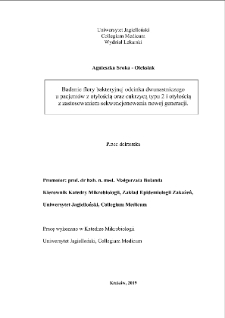Obiekt
Tytuł: The study of the bacterial flora of the duodenal segmentin patients with obesity and type 2 diabetes and obesity using next-generation sequencing
Abstrakt:
The attention of scientists is focused on the distal intestinal microbiota, while the equally important proximal parts, in which the initial stages of digestion and absorption of nutrients take place, are overlooked. The objective of the study was quantitative and qualitative analysis of the structure of duodenal mucosa microbiota in groups of patients with obesity and with type 2 diabetes (T2DM) and obesity qualified for sleeve gastrectomy. The microbiological results were compared with clinical parameters: glucose level, HbA1c, lipid profile, age and BMI. It was demonstrated that the structure of duodenal microbiota does not differ significantly between groups of patients and healthy individuals. Moreover, it was possible to distinguish the common microbiological core, including the phyla: Firmicutes, Proteobacteria and Actinobacteria. The group of patients with obesity and with T2DM presented a significantly lower number of bacteria of the genus Bifidobacterium, compared to healthy subjects. Furthermore, in the group with T2DM and obesity, the numbers of Bifidobacterium positively correlated with HDL concentration. These arguments form a basis for considering Bifidobacterium as a kind of biomarker in the diagnosis and treatment of gastrointestinal microbiota composition disorders in the course of T2DM and obesity in the future. The results indicate that the structure of duod ; enal mucosa microbiota at the phylum level is relatively constant and the changes taking place at the remaining taxonomic levels, although minor, may initiate a pathogenic effect that is intensified in later parts of the intestine.
Miejsce wydania:
Stopień studiów:
Dyscyplina:
Instytucja nadająca tytuł:
Promotor:
Data wydania:
Identyfikator:
Sygnatura:
Język:
Prawa dostępu:
Kolekcje, do których przypisany jest obiekt:
Data ostatniej modyfikacji:
19 gru 2024
Data dodania obiektu:
1 mar 2021
Liczba wyświetleń treści obiektu:
171
Liczba wyświetleń treści obiektu w formacie PDF
58
Wszystkie dostępne wersje tego obiektu:
http://dl.cm-uj.krakow.pl:8080/publication/4400
Wyświetl opis w formacie RDF:
Wyświetl opis w formacie OAI-PMH:
| Nazwa wydania | Data |
|---|---|
| ZB-132227 | 19 gru 2024 |
Obiekty
Podobne
Sroka-Oleksiak, Agnieszka
Salamon, Dominika
Stefura, Tomasz
Jagielski, Paweł
Mrozińska, Sandra Monika
Świrta, Jarosław Szymon
Cyganek, Katarzyna

